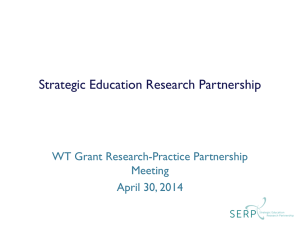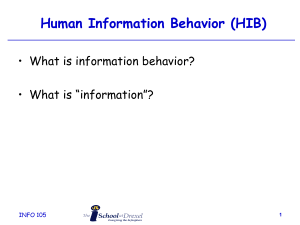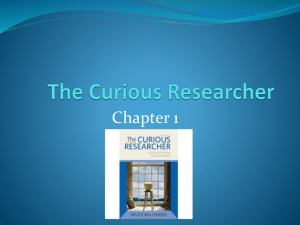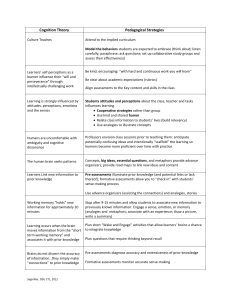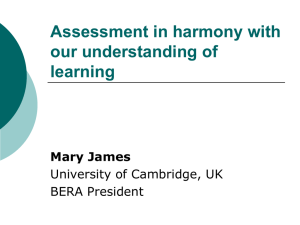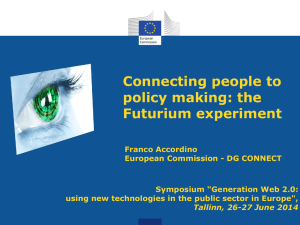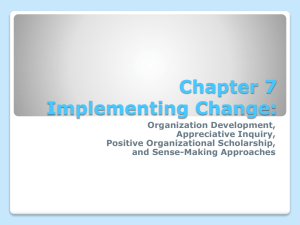3. Sense-making and decision-making
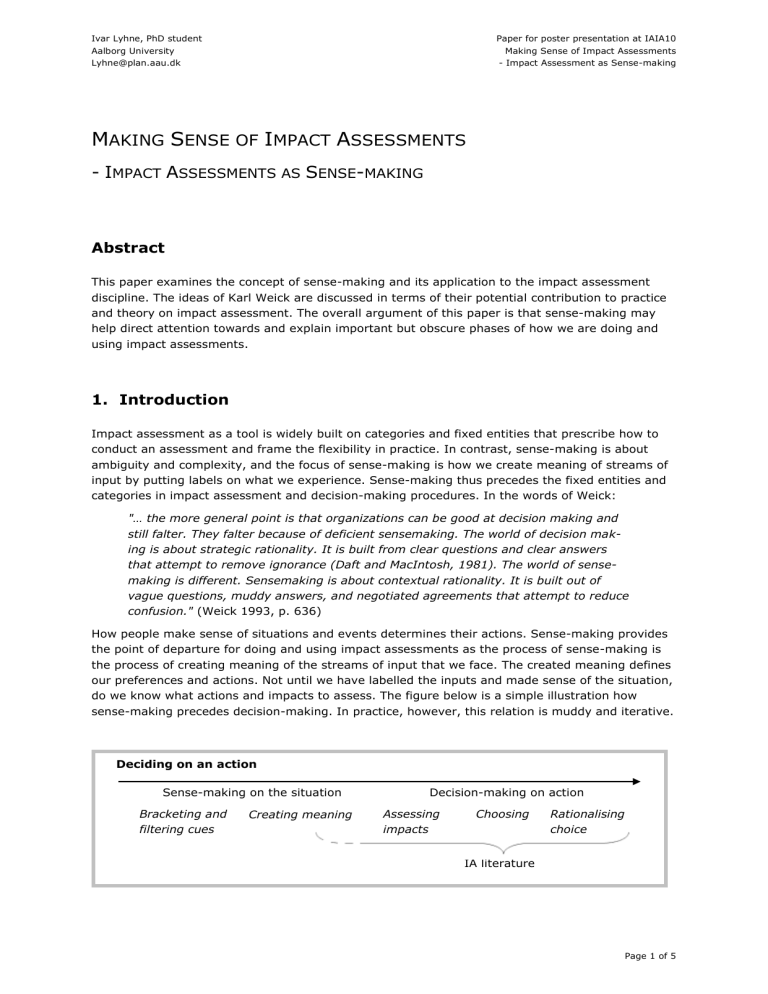
Ivar Lyhne, PhD student
Aalborg University
Lyhne@plan.aau.dk
M
AKING
S
ENSE OF
I
MPACT
A
SSESSMENTS
Paper for poster presentation at IAIA10
Making Sense of Impact Assessments
- Impact Assessment as Sense-making
I
MPACT
A
SSESSMENTS AS
S
ENSE
-
MAKING
Abstract
This paper examines the concept of sense-making and its application to the impact assessment discipline. The ideas of Karl Weick are discussed in terms of their potential contribution to practice and theory on impact assessment. The overall argument of this paper is that sense-making may help direct attention towards and explain important but obscure phases of how we are doing and using impact assessments.
1.
Introduction
Impact assessment as a tool is widely built on categories and fixed entities that prescribe how to conduct an assessment and frame the flexibility in practice. In contrast, sense-making is about ambiguity and complexity, and the focus of sense-making is how we create meaning of streams of input by putting labels on what we experience. Sense-making thus precedes the fixed entities and categories in impact assessment and decision-making procedures. In the words of Weick:
How people make sense of situations and events determines their actions. Sense-making provides the point of departure for doing and using impact assessments as the process of sense-making is the process of creating meaning of the streams of input that we face. The created meaning defines our preferences and actions. Not until we have labelled the inputs and made sense of the situation, do we know what actions and impacts to assess. The figure below is a simple illustration how sense-making precedes decision-making. In practice, however, this relation is muddy and iterative.
"… the more general point is that organizations can be good at decision making and still falter. They falter because of deficient sensemaking. The world of decision making is about strategic rationality. It is built from clear questions and clear answers that attempt to remove ignorance (Daft and MacIntosh, 1981). The world of sensemaking is different. Sensemaking is about contextual rationality. It is built out of vague questions, muddy answers, and negotiated agreements that attempt to reduce
confusion." (Weick 1993, p. 636)
Deciding on an action
Sense-making on the situation
Bracketing and filtering cues
Creating meaning Assessing impacts
Decision-making on action
Choosing Rationalising choice
IA literature
Page 1 of 5
Ivar Lyhne, PhD student
Aalborg University
Lyhne@plan.aau.dk
Paper for poster presentation at IAIA10
Making Sense of Impact Assessments
- Impact Assessment as Sense-making
At a first thought, sense-making especially takes place in the screening and scoping stages in environmental assessments; the purpose of these stages is to get an overview of the situation and decide whether a proposal should be assessed and what impacts and alternatives should be considered. However, much precedes these stages as we somehow have noticed cues about the action that have led us to conclude that screening and scoping is relevant at this point. In some cases this process is evident (we get an email from the planning department that asks us to start the assessment process of a spatial plan under development), or in other cases this process is best characterised by coincidence and muddy ideas. In the latter cases, sense-making theory may be helpful for understanding what is going on and how to improve practice. Throughout the impact assessment process, sense-making takes place as a social process between practitioners and other actors.
This paper focuses on how we as impact assessors and decision-makers notice certain elements and unknowingly ignore others in the creation of meaning. Thus only elements of sense-making theory are specifically treated. The purpose of the paper and the poster is to expand the understanding of these issues in the IAIA forum and to start a discourse on sense-making with the aim of reflecting on practice.
About sense-making
Sense-making as a concept was developed with the field of social psychology and has spread to a number of fields, including management and organisation theory (e.g. Weber and Manning 2001,
Gioia and Thomas 1996). Karl Weick is a primary author on sense-making as a socio-cognitive process within organisation research. Weick has mainly used sense-making to explain extreme events like human disasters, although his framework is relevant for any kind of events characterised by ambiguity or uncertainty:
"Two types of sensemaking occasions common to organization are ambiguity and uncertainty. The "shock" in each case is somewhat different. In the case of ambiguity, people engage in sense-making when they are confused by too many interpretations, whereas in the case of uncertainty, they do so because they are ignorant of any inter-
pretations" (Weick 1995, p. 91).
Weick has no general definition of sense-making. Instead, he describes sense-making as
The concept of sensemaking is well named because, literally, it means the making of sense. Active agents construct sensible, sensible events. They “structure the un-
known”. (Weick 1995, p. 4)
Sense-making is closely related to interpretation and cognitive psychology, but it is more than these:
"It is not interpretation as it encompasses more than how cues, information is interpreted, but is concerned with how the cues were internalized in the first instance and
how individuals decide to focus on specific cues. (Weick 1995, pp. 7-9)
"Identity construction is seen by many to be one of the two basic properties that differentiate sensemaking from basic cognitive psychology […]. The other property is
the use of plausibility as the fundamental criterion of sensemaking." (Weick et al.
2001, p. 416)
Sense-making occurs when praxis is disrupted, e.g. by events or by ambiguity. However, people first look for explanations or reasons that will enable them to resume the interrupted activity. In cases where no explanation or reasons for the disruption can be found, a sense-making process is initiated. These instances are "when the current state of the world is perceived to be different from
the expected state of the world, or when there is no obvious way to engage the world". (Weick et
Page 2 of 5
Ivar Lyhne, PhD student
Aalborg University
Lyhne@plan.aau.dk
Paper for poster presentation at IAIA10
Making Sense of Impact Assessments
- Impact Assessment as Sense-making al. 2005) Impact assessment methodology often includes a phase that initiates the latter by forcing considerations of alternative ways to engage the world.
Karl Weick's organisational version of sense-making included three core elements: Enactment, selection and retention. Enactment is the interaction with the context, and from the interaction with the context cues are selected retrospectively as part of making sense of the interaction. The selected cues are turned into a story that is plausible in terms of identity and experiences. The story is sustained in the organisation (retention) and thereby influences future enactment and selection processes. (Weick et al. 2005) In other words, sense-making is when people search for meaning of the experienced, settle for plausibility and integrate the understanding in future interaction. In contrast to the impact assessment literature, sense-making is thus "about the interplay
of action and interpretation rather than the influence of evaluation on choice" (Weick et al. 2005).
In the case of IA, enactment is formally represented by IA reports: IA report can be seen as a testing of a proposed meaning by asking for input by other actors. This enactment of a certain meaning helps adjust the sense made by practitioners.
Weick argue that social interaction is needed to grasp complex systems. This interaction forms structures that enable reactions on hints and cues. Structures may be structural frameworks or shared interpretive schemes that stabilises meaning and enable actions. At the same time Weick questions whether these structures are flexible enough to negotiate strangeness. In analyses of disasters like the Mann Gulch disaster (1993), Weick argue that the shared schemes were too fixed to allow for more adequate interpretations of the situation. Weick concludes:
"And we find that social sensemaking may be most stable when it is simultaneously constitutive and destructive, when it is capable of increasing both ignorance and
knowledge at the same time" (2001, p. 647)
2.
Making sense of environmental impacts
How we make sense of situations from the basic bracketing of cues determines what impacts we judge significant and include in our assessment.
From the point of view of sense-making theory, impact assessment is a structured and formalised approach to make sense of a situation. The structuring is, however, only covering parts of the sense-making process. In the following a story of Weick's is used to show what precedes an impact assessment.
The story about the nurse
One of the stories used by Weick to enlighten us about sense-making is about a nurse who during her routine activities is noticing and bracketing cues in the streams of events and inputs that surround her.
"During her routine activities, the nurse becomes aware of vital signs that are at variance with the “normal” demeanor of a recovering baby. In response to the interruption, the nurse orients to the child and notices and brackets possible signs of trouble for closer attention." (Weick et al. 2005)
The nurse is trying to find meaning of some signs that are new to her and this process is guided by the nurse's mental models that lead her to notice and understand specific cues and (temporarily) ignore others. The bracketing of cues eventually leads her to labelling the baby's signs, and thereby ambiguity is replaced by simplicity and the hospital system can start treating the baby.
Page 3 of 5
Ivar Lyhne, PhD student
Aalborg University
Lyhne@plan.aau.dk
Paper for poster presentation at IAIA10
Making Sense of Impact Assessments
- Impact Assessment as Sense-making
So what is the relevance of this story for impact assessors? It provides an explanation of how we notice and bracket signs about impacts that we are not sure whether to include in our impact assessment - a process that the IA literature is not explaining well. Let's retell the story and put ourselves - environmental coordinator or the like - in the nurse's place and replace the baby with an environmental impact:
During our impact assessment, we become aware of signs of environmental impacts that are not easily labelled by our experiences. In response to this interruption, we orient to this impact and notice and bracket possible signs of significance for closer attention.
Sense-making thus takes place when we have no experience or labels for a certain action or impact and thus have to create meaning of what it is and how it fits into our mental frameworks for conducting assessments. Such action could be related to new technology to which we have no or limited knowledge about environmental impacts. The "baby" could also be a new or ambiguous kind of development to which we bracket signs of significant impacts. Or it could be a plan which we are neither sure about whether to assess nor how to do so. In this case, we look for signs of significance that may lead us to label the development so that we can relate it to impact assessment requirements.
Cartography and unanticipated consequences
Weick (2001, p. 9) uses the notion of 'cartography' to explain the existence of an infinite number of plausible maps of the reality. Doing an impact assessment can be seen as making a map of the reality that is as good as our resources (time, mental, knowledge) permit. Being more aware of how we search for cues that lead us to create meaning for events and impacts may improve our maps of impacts and lead us to less unanticipated consequences:
"To ignore sensemaking is to encourage severe unanticipated consequences. Sensemaking doesn't prevent unanticipated consequences. But it does slow their development. And it allows people to sense unanticipated consequences at an earlier stage before they have incubated into irreversible trouble", (Weick 2001, p. 423)
3.
Sense-making and decision-making
The importance of how and what cues are noticed and bracketed also concerns the readers of the
IA, e.g. directors, the public, and other agencies. The creation of meaning for environmental impacts is determined by what decision-makers notice and bracket when reading the environmental report or listening to the impact assessors.
Theories on decision-making typically focus on values and understanding of uncertainties among decision-makers. Little focus is placed, however, on how these aspects are developed and ignited by the bracketing of certain cues, in spite of its importance. In IA literature, much focus is on the influence and effectiveness of IA in terms of decision-making, which is seen as central for fulfilling aims of promoting sustainable development. IA literature provides insight into a wide range of aspects related to this challenge, including when and how impact assessments are used and misused.
Sense-making theory may add to this knowledge by providing a framework for investigating how impact assessments interact with the way practitioners and decision-makers make sense of a situation.
Based on the widely explanatory sense-making theory, more 'active' concepts are developed.
"Sense-giving" is described by Gioia and Chittipeddi (1991) as "the process of attempting to influ- ence the sensemaking and meaning construction of others toward a preferred redefinition of organ-
izational reality." (p. 442) Whether impact assessment is an act of sense-giving depends on the
Page 4 of 5
Ivar Lyhne, PhD student
Aalborg University
Lyhne@plan.aau.dk
Paper for poster presentation at IAIA10
Making Sense of Impact Assessments
- Impact Assessment as Sense-making role assigned to the assessment. However, it is obvious that impact assessments include a preferred definition of reality in the frame of sustainable development. An obvious follower of "sensegiving" is the concept of "sensegiving contests" (Maitlis and Lawrence 2007) in which different actors try to influence other actors' views on a given action. Impact assessment can be seen as a part of this political game and the influence on decision-making depends on the success of its proponents in the contest. Public consultations can for instance be explained as a contest between different ‘senses’ made among different persons on the same situation.
4.
Using sense-making to improve IA
Sense-making points at the importance of being reflexive about how we notice and bracket cues, as these processes define our meaning of a situation. Sense-making points at achieving a balance between how fixed and flexible our mental structures must be to enable action and at the same time challenge understandings. Ingrained capabilities and interpretative schemas based on experiences may form our basis for IA, but at the same time also limit our awareness of cues of abnormal and unexpected impacts or developments.
Sense-making may add to IA theory and practice by enhancing our awareness of
• How cues are ‘read’: Cues may have strategic importance and the ‘reading’ of these is affecting uncertainty and ambiguity in an organisation. Awareness of the ‘reading’ may help us to avoid missing important impacts in IA.
• How problems/opportunities are framed: A deep understanding of how we go about making sense of what is happening and what will happen may improve our framing and communication of IA. This concerns impacts, measures and alternatives in the IA process.
• How users are making sense of IA: Sense-making theory may improve our understanding of how decision-makers and other users are making sense of IA. It may be possible to use this knowledge for targeting our communication to the users.
This paper only outlines the relevance and potential of sense-making for the discipline of IA. The paper is part of a PhD study on sense-making and SEA that is planned to specify how and what to learn from sense-making and elaborate on these aspects empirically.
References
Craig-Lees, M. 2001, Sense making: Trojan Horse? Pandora's Box?, in Psychology & Marketing, Vol.
18, No. 5, p. 513.
Gioia DA, and Chittipeddi, K, 1991, Sense-making and Sensegiving in Strategic Change Initiation, in Strategic Management Journal, Vol. 12, No. 6, pp 433-448
Maitlis, S, and Lawrence, TB, 2007, Triggers and Enablers of Sensegiving in Organizations, in
Academy of Management Journal, Vol. 50, No. 1, pp. 57–84.
Weber, PS, and Manning, MR, 2001, Cause Maps, Sensemaking, and Planned Organizational
Change in Journal of Applied Behavioral Science, Vol. 37, p. 227
Weick, KE 1993, The Collapse of Sensemaking in Organizations: The Mann Gulch Disaster, in Ad-
ministrative Science Quarterly, Vol. 38, No. 4 (Dec., 1993), pp. 628-652
Weick, KE 1995, Sense-making in organizations, Sage Publications
Weick, KE 2001, Making Sense of the Organization, Blackwell Publishers
Weick, KE, Sutcliffe, KM, and Obstfeld, D. 2005, Organizing and the Process of Sense-making, in
Organizational Science, Vol. 16, No. 4, pp. 409–421
Woodside, A. 2000, Introduction, in Woodside, A. (ed.) 2000, Getting better at sensemaking, Emerald Group Publishing, ISBN: 0762306335.
Page 5 of 5

